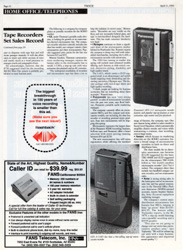Flashback Recorder
Weighs Three Oz. - by James K. Willcox
Weighing in at less
than 3 ounces and taking up approximately the same amount of space
as three stacked credit cards, the Flashback digital personal
recorder from Norris Communications is nonetheless capable of
storing up to 30 minutes of speech in flash memory, making it
suitable for a number of applications beyond storing personal
memos.
Flashback uses a
proprietary storage technology called SoundClips, which are
removable solid-state, non-volatile flash memory chips that allow
up to 30 minutes of recording to be randomly accessed. Unlike
magnetic tape, SoundClips can be reused repeatedly without sound
degradation and are virtually impervious to extreme temperatures.
Because the removable
SoundClips use a PCMCIA-compatible interface, Flashback can be
used to communicate with other electronic devices, such as
personal computers, electronic organizers or PDAs.
Woody Norris,
president of Norris Communications, which developed the product,
says he expects to have 60- and 120-minute SoundClips available
within the next year.
Flashback carries a
suggested retail price of $199.95, including a 30-minute SoundClip,
batteries and accessories. Additional 30-minute SoundClips are
priced at $69.95, although Norris expects street prices to hit $30
later this year.
Down the road, Norris
says, will be a more advanced Flashback model that will feature
infrared wireless capability and an LCD screen. He also expects to
have an OEM client that will market the original Flashback under
its brand name.
While Flashback is
initially being positioned as a voice recorder, Norris admits the
device--particularly the advanced model--will surely be capable of
more ambitious undertakings, though he declines to be specific.
"The
mircoprocessor can do much more than what we're using it
for," he states. "We went for overkill on the
processor."



